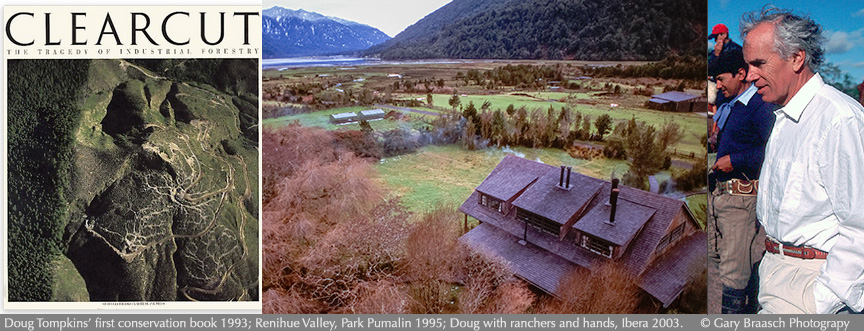Doug Tompkins, preserver of South American wilderness, a “one-man Nature Conservancy,” leader of the modern deep ecology movement, and one of the founders of the modern outdoor adventure clothing and fashion industry, died December 8 in a kayak accident in Chile.

He was among old friends, according to reports, doing what he loved, on a lake in a mountainous, forested landscape he was helping to preserve. High winds drove five foot waves into the kayaks, and Doug and his partner in a double-kayak, mountaineer Rick Ridgeway, capsized 200 yards from shore. By the time party members and a local helicopter brought Doug to shore, he had been in the frigid waters for two hours. Medical teams were unable to revive him from severe hypothermia.

Doug was a skier, kayaker and mountaineer and a brilliant business person in the 1960s and '70s who co-founded The North Face and, later, Esprit, with his first wife Susie. But the mountains, especially in Chile and Argentina, and the urgent need of an antidote to environmental destruction, won out. Preserving as much wilderness as possible became his life’s passion. With more than $100 million from sale of his share of the business, in the early 1990s Doug created the Foundation for Deep Ecology and then began buying land just north of Patagonia in Chile. He married Kristine McDivitt who for 20 years before had been the president of Patagonia, helping founder Yvon Chouinard create its influential model of corporate ecological responsibility. Together Doug and Kris have founded two South American land trusts and, according to one accounting, have "protected more land than any other private individuals in history” — 917,000 hectares (2.2 million acres) of dedicated protection including new Chilean and Argentine national parks, and millions more acres in surrounding land that is better managed because of their efforts.

I met Doug in 1995 to photograph him for a New York Times Magazine article by Jon Bowermaster, “Take this park and love it.” Jon wrote that for $12 million, Doug had "acquired 670,000 acres of pristine forest, mountains and rivers that cut the nation in two, stretching from the Argentine border to the Pacific Ocean. His intention is to turn the land into a park open to the public -- the largest private park in the world, he says -- and eventually to hand it over to Chile's national park system.” The story also was — and has been for much of the succeeding two decades — about Doug’s determination bordering on arrogance, which often appeared to Chileans like a gringo millionaire who was going to bisect the nation by secretly buying up economically valuable forests, rivers, lakes and mountains.
But Doug continued to buy land, while building confidence with legislators, conservationists, and locals. The foundation Doug created, The Conservation Land Trust, created Parque Pumalin, open to the public as a private national park that includes ocean fjords, ancient rare forests, glaciers and active volcanoes. Other national parks and protected areas bought by Doug and Kris with other donors extend from the Argentine Atlantic coast to Patagonia and Tierra Del Fuego.

I saw Doug again and met Kris in 2003 while photographing for them in the Ibera wetlands, a 3.2 million acre northern Agentinian region which is another national park project by Doug and the Conservation Land Trust. The aerials I shot there were from Doug’s plane after I had been in the wetlands for three weeks being guided by the local gauchos — who go barefoot in their saddles because they are often in water up to the horses’ bellies.
But my first introduction to Doug was in 1993 when he flew his light plane to the tiny Nehalem Bay airstrip near where I lived on the Oregon Coast to invite me to contribute to a book he was planning about the abuses of clearcutting native forests. His impetuousness and drive were in full display —he didn’t call first and I was away on a shoot. He just showed up and presented my then wife with the idea! I provided many images and an assignment shoot in Alberta. The resulting 4 pound book, "Clearcut: The Tragedy of Industrial Forestry” was a bombshell with its richly detailed essays on forest management and page after page of photos of pristine ancient forests and how commercial over-logging was destroying them. Doug, the Foundation for Deep Ecology and his publishing partners and editors went on to produce many more large format books bringing conservation issues to the public, including Fatal Harvest, Wildfire and Welfare Ranching; and a superb series of even larger books on the South American conservation lands.

Doug Tompkins was a mentor and a friend, and a demanding, uncompromising inspiration to apply all one has to the endless, crucial work of protecting our planet. He lives on in his family, his foundations and the ecosystems he loved so much that he bought them to give them all back to the world.
Gary Braasch is a leading environmental photojournalist who creates remarkable images and reports about nature, environment, biodiversity and global warming around the world. More...

